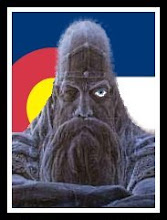 Conifers
Conifers~~~~~*~~~~~
Pine, Fir, Spruce, Hemlock/Larch, Cedar, Cypress and Yew...the resinous, shrubs and trees are "conifers"...most bear "cones" instead of fruit. They are some of the oldest herbaceous plants still extant on the planet.
~~~~~*~~~~~
(1) Grand Armoire in the Bavarian Style

This armoire is constructed from Northern White pine, Ponderosa Pine, Sugar Pine, Hem/Fir plywood panels faced with Ponderosa Pine veneers.

The case stands 9' 6" high X 64" wide X 30" deep. The crown, a carved panel, is made of Sugar Pine, carved in a rustic, eclectic Austro-Hungarian style. The stag or elk is the focal point.
 The interior was designed to be an entertainment center, housing a small projection screen TV, audio/visual equipment and storage drawers for DVD, CDs and VCR's.
The interior was designed to be an entertainment center, housing a small projection screen TV, audio/visual equipment and storage drawers for DVD, CDs and VCR's.
(2) Santa Fe style side table
It is a occasional table 28"wide X 16" deep X 30" high
This rustic little table might seem innocuous and simple. The untrained collector would pass by with a yawn and not another thought. In fact, it is a well designed piece which makes use of joinery, not adhesives to allow it to hold together in the harsh environment of the southern Rocky Mountains around Taos and Santa Fe.
The legs, top, sides, front and back and stretchers are made from air dried Hemlock, chosen for clear, straight grain without knots.
The top is held to the base by a series of through tenons attached to spines which are in turn attached to the base sides with cleats....allowing for seasonal movement.
The sides, front and back, and the two lower stretchers are joined to the legs with full through tenons which are pinned with dense, second growth spruce trunions.
Look closely and you will see that the sides pierce the legs with double tenons while the face and back pierce the legs with single tenons.
The finish is a traditional creosote based stain and wax finish....stinky and a good deterent against insects.
(3) Station Masters Desk
This CVG (clear vertical grain) Ponderosa Pine desk stands 30" tall at the desk top, 48" tall at the gallery top X 66" wide X 42" deep.
 Back in the late 1980's, I was employed as a master cabinetmaker for Stuart-Buchanan Antiques here in Denver. I was charged with the design and construction of custom furniture to match British and Continental antiques.The desk above looks like a fine railway clerk's desk from the 19th century. In fact, it is a sophisticated document safe. The lower drawers are locked in place by the center drawer which is secured by an unseen locking mechanism. The plinth bases under each pedestal hide two steel compartments secured under what look like simple file drawers.It is constructed using modern stick and cope, raised panel methods and modern drawer construction and joinery. The same goes for the finish. It is a oil base stain and nitrocelluose laquer finish.BTW..............There is a pistol drawer hidden within the gallery. Yeah, go ahead, find it.
Back in the late 1980's, I was employed as a master cabinetmaker for Stuart-Buchanan Antiques here in Denver. I was charged with the design and construction of custom furniture to match British and Continental antiques.The desk above looks like a fine railway clerk's desk from the 19th century. In fact, it is a sophisticated document safe. The lower drawers are locked in place by the center drawer which is secured by an unseen locking mechanism. The plinth bases under each pedestal hide two steel compartments secured under what look like simple file drawers.It is constructed using modern stick and cope, raised panel methods and modern drawer construction and joinery. The same goes for the finish. It is a oil base stain and nitrocelluose laquer finish.BTW..............There is a pistol drawer hidden within the gallery. Yeah, go ahead, find it.~~~~~*~~~~~
















 Back in the late 1980's, I was employed as a master cabinetmaker for Stuart-Buchanan Antiques here in Denver. I was charged with the design and construction of custom furniture to match British and Continental antiques.
Back in the late 1980's, I was employed as a master cabinetmaker for Stuart-Buchanan Antiques here in Denver. I was charged with the design and construction of custom furniture to match British and Continental antiques.













